Read the forum code of contact
By: - 14th December 2008 at 23:31 Permalink - Edited 1st January 1970 at 01:00
H_K, this certainly is an interesting topic and you have made an excellent post, however I would argue that the categorisation is somewhat artificial as is demonstrated by the fact that your largest vessel has twice the displacement of your smallest and is only about 16,000t short of a Nimitz.
We also have a number of distinct groups here, firstly there are the war built hulls that were reused. I would argue that Victorious and Eagle are the most impressive in this sense only because of the extremely thorough nature of their reconstructions. Obviously Midway falls into this category too. However they are also limited by their size. They were the biggest carriers around when laid down but their is only so much you can do to a hull. The british ships fall into a category that I like to call battle carriers, these are ships that are primarily orientated towards peer rival warfare, in this case with the Soviet Union. Thus there rebuilds produced ships designed to cooperate with AAW destroyers and act as platforms for strike aircraft armed with nuclear AShM's intended to destroy Stalin's heavily armoured surface units. CdG follows this battle carrier doctrine but she is an unfortunate compromise that has resulted in a vessel that is really a bit to small and that suffers from poor availability that raises serious questions about the usefulness of a single carrier to a navy. In many ways the ship is a hangover from the cold war and it is worthy of note that the french took a very different approach with the Mistral class and the thus far still born PA-2. PA-2's sister, CVF, is a very different concept to the previously mentioned ships, rather than a battle carrier the class is the product of western naval and political dominance. The ship is not expected to engage anything near a peer rival and is thus expected to act as platform for amphibious and strike operations against much weaker entities. therefore the class lacks the mass missile and CIWS armament of the likes of CdG and the proposed CVA-01. I would argue that CVF is the very pinnacle of carrier design and a perfect representation of how procurement should follow doctrine that should follow foreign policy. When these ships are commissioned and combined with the UK's exisiting very impressive amphibious fleet along with Tomahawk firing Astutes and Apache and Chinook carrying LPH's the UK will have a power projection capability unseen in Europe since the collapse of the great Empires. Indeed I would argue that given the current world security environment Britain should make a high priority of pushing for two LPH's rather than further surface combatants.
By: - 15th December 2008 at 00:33 Permalink - Edited 1st January 1970 at 01:00
By necessity I had to draw the line somewhere. I admit that it may seem arbitrary, but IMHO there's some logic to counting CVF and Midway as medium carriers - after all, they're significantly smaller than the USN's super-carriers.
Similarly, I chose to exclude Hermes on the low end of the scale, because IMHO it's closer to a light carrier - even when comparing to Victorious.
By: - 15th December 2008 at 00:51 Permalink - Edited 1st January 1970 at 01:00
CdG follows this battle carrier doctrine but she is an unfortunate compromise that has resulted in a vessel that is really a bit to small and that suffers from poor availability that raises serious questions about the usefulness of a single carrier to a navy.
What's interesting when you compare CdG to the other medium carriers is that it's aviation capabilities are actually quite good. Certainly better than Ark Royal or an Essex - which is to be expected given that it's a modern design.
So if Ark Royal and the Essexes could be considered viable battle carriers in the 1960s-70s, then CdG should still be a viable battle carrier today. IMHO CdG's unflattering reputation is somewhat undeserved and has more to do with its poor airgroup (obsolescent Super Etendards + a smattering of Rafales without folding wings) rather than any inherent design flaws for CdG.
By: - 15th December 2008 at 00:56 Permalink - Edited 1st January 1970 at 01:00
Britain should make a high priority of pushing for two LPH's rather than further surface combatants.
^^... Does make a valid point but the navy would need great restructuring and the surface combatants of the fleet are in a dire mess.. C.2 should ideally be entering service around 2016 (with the first few hulls replacing the T22B3's and the later hulls replacing the T23's without the T2087's), it is a no thrills warship and doesn't dip into the funds that much, C.1 isn't likely to enter service until after Vanguards are replaced (the remaining T23's will be SLEP'd no doubt about it)[i do realise this means the only vessel capable of serving as a task force flag ship is the expensive to operate T45 but there are little alternatives] so there should be enough yard space and funds for 2 new lph's with ISD's of Early 2021 and late 2022 (wouldn't be too hard to expect the Ark to serve until 2021 and Ocean to 2022)
By: - 15th December 2008 at 01:13 Permalink - Edited 1st January 1970 at 01:00
^^... Does make a valid point but the navy would need great restructuring and the surface combatants of the fleet are in a dire mess..
Are they? The Type 23's are still very powerful ships and there are plenty of upgrades to keep them that way. They are far from a dire mess. And the Type-45's are exceptional AAW ships with good command facilities but lacking an enemy for the very high end PAAMS system to deal with.
C.2 should ideally be entering service around 2016 (with the first few hulls replacing the T22B3's and the later hulls replacing the T23's without the T2087's), it is a no thrills warship and doesn't dip into the funds that much, C.1 isn't likely to enter service until after Vanguards are replaced (the remaining T23's will be SLEP'd no doubt about it)[i do realise this means the only vessel capable of serving as a task force flag ship is the expensive to operate T45 but there are little alternatives] so there should be enough yard space and funds for 2 new lph's with ISD's of Early 2021 and late 2022 (wouldn't be too hard to expect the Ark to serve until 2021 and Ocean to 2022)
We will see what happens with the surface combatants, I would not be at all surprised to see the Frigate fleet replaced with something quite different from what is currently being discussed. Beyond the obvious funding issues and the fact that the T23's are good for another decade the RN also seems to be grappling with the difficulty of defining what it actually needs the ships to do. Overseas inspiration is lacing due to the unique composition of the RN with possibly only the RNLN OPV's now entering production offering a potential post cold war example. This is not the subject of this thread and further discussion would be to distract from an interesting topic but the biggest problem for the RN frigates is deciding exactly what missions they need to undertake.
By: - 15th December 2008 at 01:26 Permalink - Edited 1st January 1970 at 01:00
I'm reposting the image, but in a larger size. This shows the details better. :-)
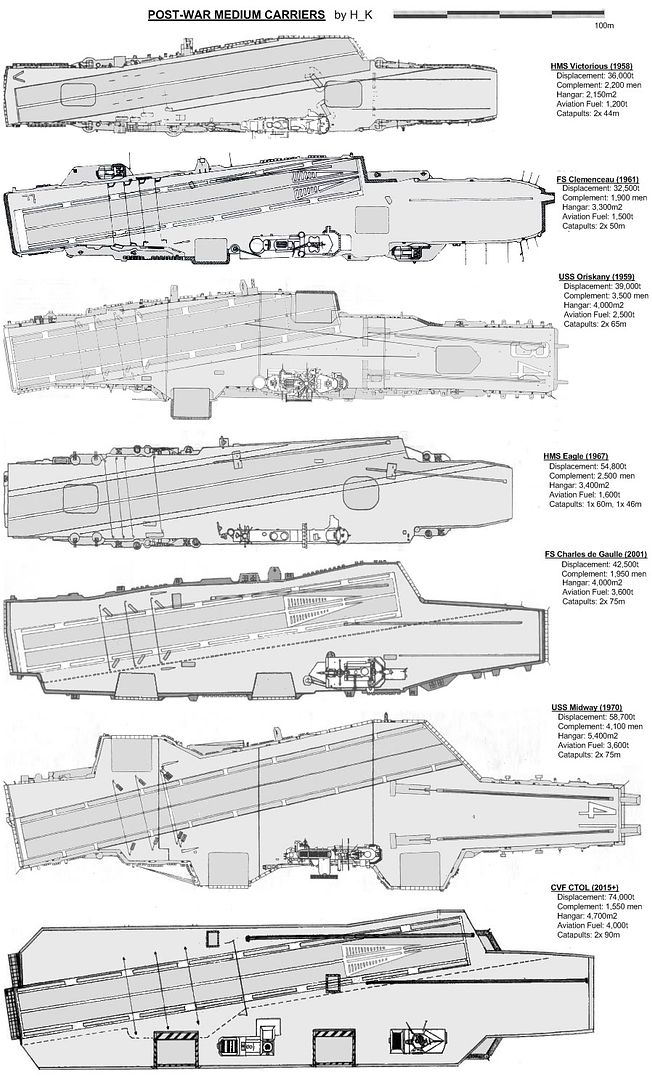
By: - 15th December 2008 at 18:12 Permalink - Edited 1st January 1970 at 01:00
I'm a bit baffle by HMS Eagle: greater tonnage than FS CdG yet obviously smaller and only slightly smaller tonnage than USS Midway, which is bigger than both Eagle and CdG.
By: - 15th December 2008 at 18:37 Permalink - Edited 1st January 1970 at 01:00
The drawing of Victorious demonstrates one of the reasons i like that vessel so much. After her reconstruction she was a very modern and cleaning looking design and that comes out in the above image when compared to the likes of the Oriskany and Midway.
By: - 15th December 2008 at 20:09 Permalink - Edited 1st January 1970 at 01:00
I'm a bit baffle by HMS Eagle: greater tonnage than FS CdG yet obviously smaller and only slightly smaller tonnage than USS Midway, which is bigger than both Eagle and CdG.
Eagle had two hangar decks and an armoured flight deck compared to CdG.
By: - 15th December 2008 at 22:50 Permalink - Edited 1st January 1970 at 01:00
The drawing of Victorious demonstrates one of the reasons i like that vessel so much. After her reconstruction she was a very modern and cleaning looking design and that comes out in the above image when compared to the likes of the Oriskany and Midway.
Victorious has very clean lines. A beautiful ship, but a bit too marginal for my liking. For me, Clemenceau and Oriskany come closest to the "ideal" 1960s medium carrier (Oriskany would have needed a steel deck, though).
Here's an updated drawing. This time I've added Hermes, though IMHO it's even more marginal than Victorious and shouldn't really belong in this list. Compared to Victorious, Hermes has a few key shortcomings:
- Slower: 28kts vs. 31kts, with a realistic speed of 23.5kts during catapult launches (http://books.google.com/b...=hermes+carrier+catapult)
- Smaller, leading to less deck parking
- Only one "long" catapult
- Tons of equipment taken out to keep its top weight down (including almost all AA armament)
I've also added the deck safety line for Clemenceau.

By: - 16th December 2008 at 04:50 Permalink - Edited 1st January 1970 at 01:00
Talking about modern vessels only, I think the classification could be light - straight deck, medium - 2cat, large - 4cat.
To qualify as fleet carrier the vessel also has to have decent speed and a conflict-free (as far as possible) deck and hangar flow concept. Here a 2cat/2lift design has conceptual advantages over the 4cat/3(4)lift design (even though the Ford class is a thing of beauty, I have to admit).
Today only CdG qualifies, even though they built her the wrong way round (the aft lift should be on larboard, and the island and forward lift switch places), and her displacement is at the absolute minimum.
Now, the CVF as shown is not a medium carrier by displacement. And again the aft lift should be on the other side (to serve the larboard cat), and the starboard cat is conflicting with the angled deck. And of course CVF is too slow for a fleet carrier.
You should also include the Kuznetsovs here as medium, even though their ops concept is totally different from Western carriers.
By: - 16th December 2008 at 08:16 Permalink - Edited 1st January 1970 at 01:00
To me (and as the USN found in operational service) the SCB-101.66 (1967-70) modification to Midway was a bit too extreme.
While Coral Sea's SCB-110A modification didn't produce quite as much deck park, and had smaller and lighter weight-lifting elevators, she never had Midway's problems with elevators being too close to the water or the stability problems (excessive rolling in calm seas) produced when they tried to reduce how low Midway sat.
Coral Sea in her SCB-110A (late 1950s) guise:
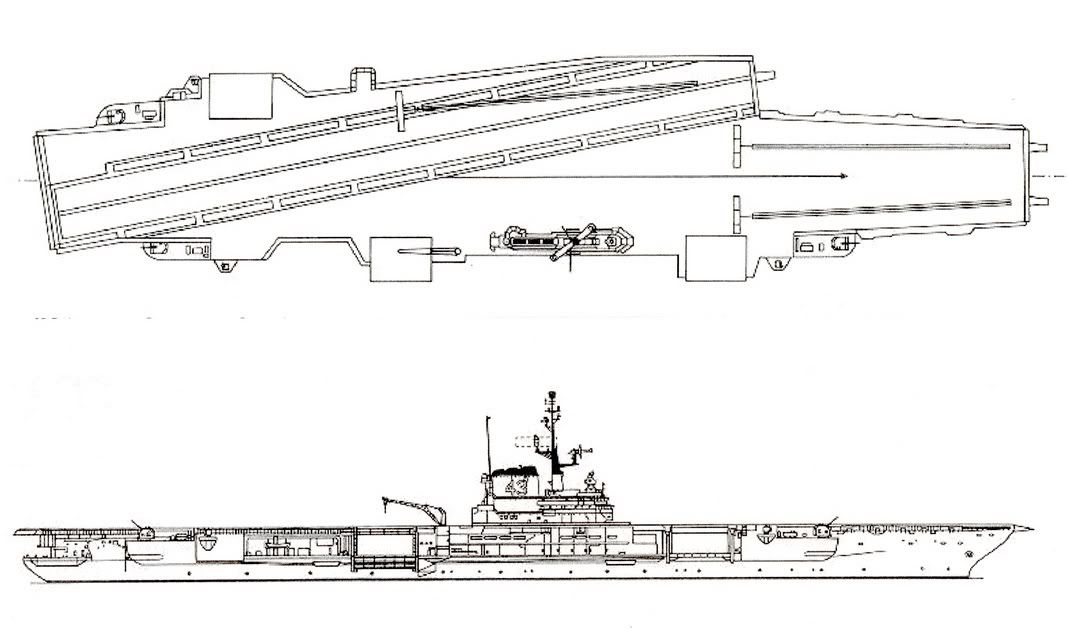
Midway & Franklin D. Roosevelt in their SCB-110 (early 1950s) guise:
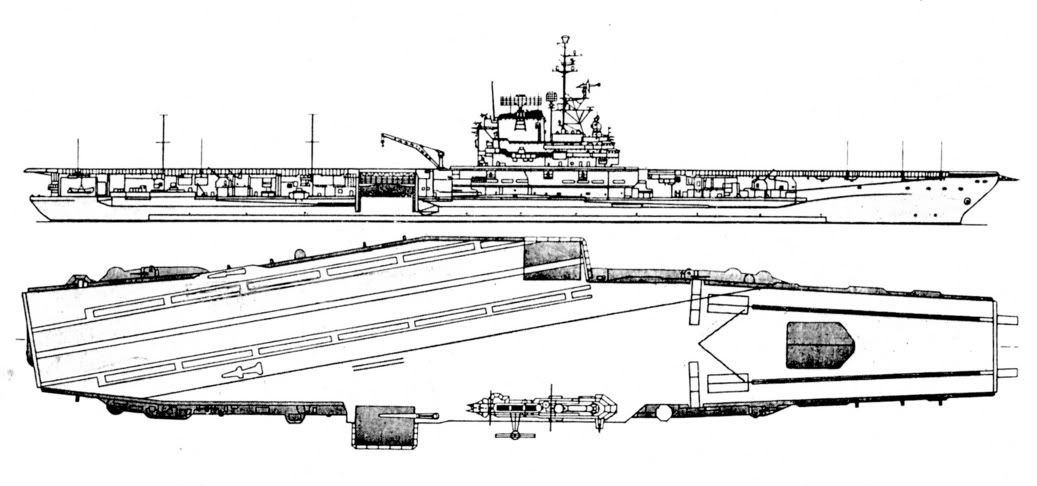
FDR in her final "austere" (1968) guise (she had been intended to be modernized as per Midway's SCB-101.66, but that cost too much, so she only got a little work to carry her through her last ~5 years of service).
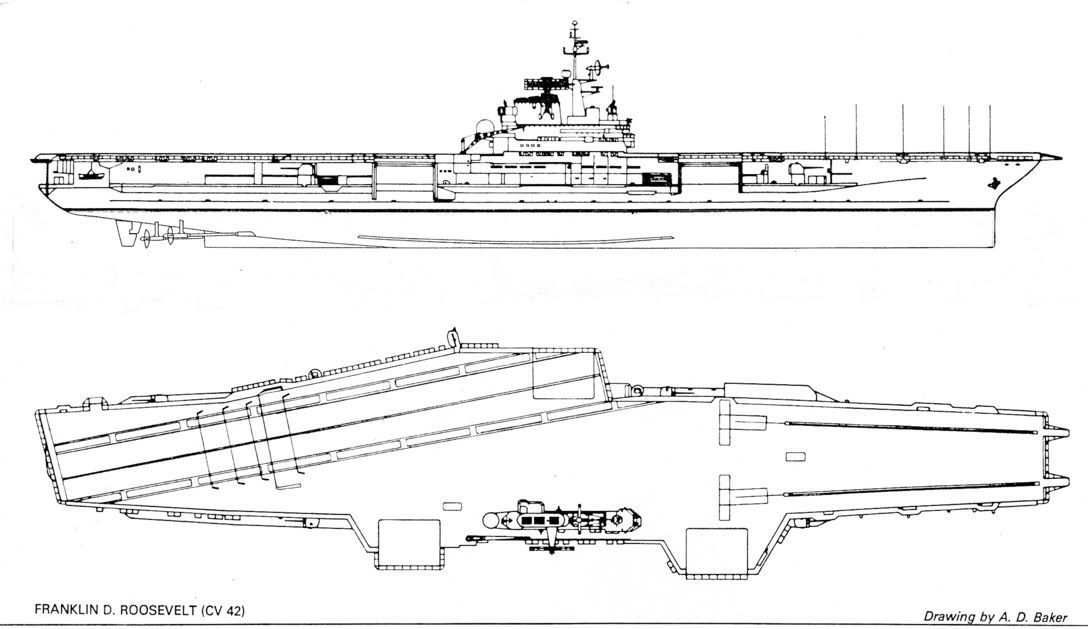
In my book, both Midway & FDR should have been done virtually identical to Coral Sea, the lower cost would have allowed both to be done, and there would have been little "real-world" difference to Midway's capabilities... and FDR would have stayed in service longer as well.
Something like this:
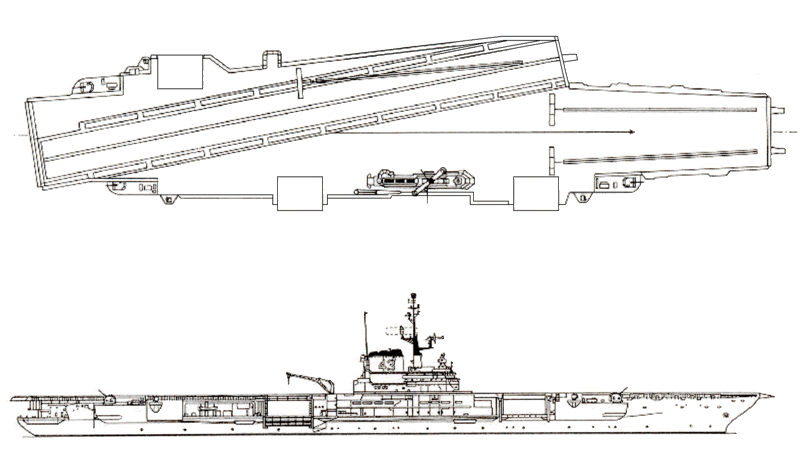
By: - 16th December 2008 at 17:29 Permalink - Edited 1st January 1970 at 01:00
I don't their is any need for a Larbord lift as the USN have deleted them since the JFK Kittyhawk class as they found moving the plane back to the lift after it had landed much harder than moving it forward. Likewise they found the Larbord lift to interupt the landing cycle when moving planes up to the lift.
The CVF is capable of 28kn so if you can Class CdG as a medium carrier the same applies to the CVF.
Distillier keeping the lifts on one side eases aircraft movement as all carriers since JFK have proven[im counting only deck edge carrier].
By: - 16th December 2008 at 17:38 Permalink - Edited 1st January 1970 at 01:00
.....Distillier keeping the lifts on one side eases aircraft movement as all carriers since JFK have proven[i'm counting only deck edge carrier].
Yes, but would it not lead to significant vulnerability as well? Having at least one lift on both port and starboard sides decreases vulnerability that enemy action of some sort could knock out the ship's ability to conduct air ops.
By: - 16th December 2008 at 19:23 Permalink - Edited 1st January 1970 at 01:00
@H_K , I just want to say that you drawings simply ROCK!!! :cool:
________
Wilhelm hofmeister (automobile designer)
By: - 16th December 2008 at 19:58 Permalink - Edited 1st January 1970 at 01:00
I don't their is any need for a Larbord lift as the USN have deleted them since the JFK Kittyhawk class
Really???
What's this on the aft end of the angle deck (port/larboard side) of USS Nimitz (post JFK/Kitty Hawk)?
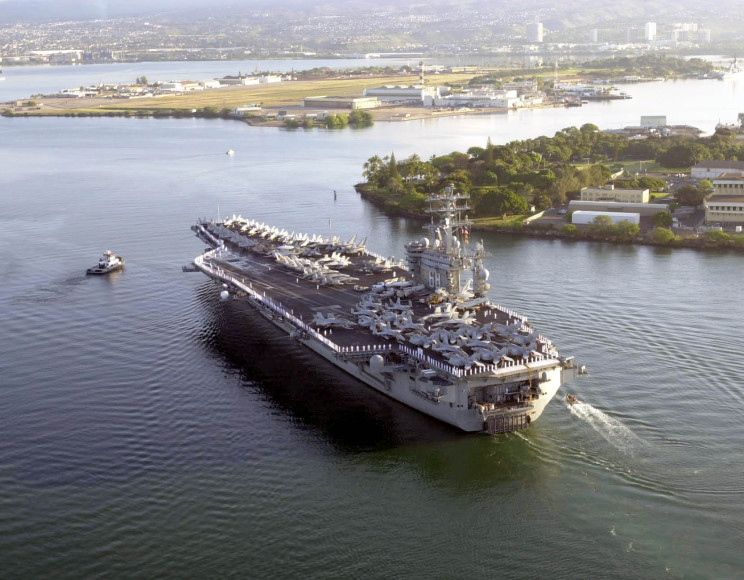
Or here on USS Harry Truman (the 8th Nimitz class CVN)?:

Or on the not yet commissioned USS George H.W. Bush (10th Nimitz)?:
Or planned for CVN-78?:


By: - 16th December 2008 at 20:43 Permalink - Edited 1st January 1970 at 01:00
The reason they deleted the third lift on starboard on the Fords is that it is of no benefit for the flow of aircraft. (And they also found earlier, that conflict free simultaneous landing/take-off ops are worth more than a symetric 4-lift layout, like on the Forrestals). Old stuff.
But I dissent on the point, that a 2-lift layout benefits from same-side lifts. This layout forces CdG to taxi back and forth the planes and totally disrupts the flow. With an aft larboard lift and a forward starboard lift a clear flow pattern could have been established with the angled deck cat the standard cat (without a launch-ready aircraft disturbing landings), and the bow cat the surge cat.
An interesting concept is to put a small fighter-sized central lift forward at the extreme end of the hangar deck, so that a landed aircraft can directly taxi onto it. The handling of larger planes would require more time, though.
PS: Who ever said that CdG is not faster than CVF is right. But thanks to the nuclear propulsion CdG can actually maintain that speed. (Then again, both are limited by their escorts' endurance - which again shows that nuclear powered carriers should have nuclear powered escorts).
By: - 17th December 2008 at 00:04 Permalink - Edited 1st January 1970 at 01:00
Distiller,
I'm not sure I understand your "flow" comments. Is this what you're talking about?
1. After recovery, planes flow from the angle deck directly to a forward lift on starboard (in front of the island)
2. Planes use the forward lift to enter the the hangar and then flow back towards the stern
3. Planes are brought up to deck through the stern lift (to port), from where they can be easily positioned on the stern catapult, without interrupting recovery operations
Although I agree this is "ideal", I don't think it's very realistic.
First, I'm not sure planes "flow" through the hangar that way - that would require constant movements. Might be better to use a "back and forth" flow model, where planes enter and exit the hangar using the same lift. To keep plane movements to a minimum, you'd locate planes undergoing extensive maintenance furthest from the lift, and airplanes that are going to be turned around fast close to the lift.
Second, most two catapult carriers are going to be too small to position aircraft on the stern catapult without disrupting recovery operations. The only catapult that can be deconflicted is the bow catapult, and even then it has to be located on starboard, which reduces deck parking. If you decide to prioritize deck parking (as the French did), then you have to give up simultaneous launch & recovery operations, which makes a more sequential rather than linear flow OK.
By: - 17th December 2008 at 01:55 Permalink - Edited 1st January 1970 at 01:00
Continuing on the topic of "flow"... I've drawn three options for deck layouts, to illustrate the discussion we're having. My understanding is that Distiller is arguing for Option 3. I personally like Option 1.
Option 1: CdG layout with two lifts on starboard behind island and catapults on port. This has the advantage of clear separation between deck parking and launch & recovery areas, with maximum deck parking. The flow looks alright to me too, considering launch & recovery operations are sequenced.
Option 2: Bow catapult moved to starboard and one lift moved forward of the island. IIRC, this option was considered for CdG and had several merits, including simultaneous launch & recovery. However it has less deck parking and the flow could also be problematic since both recovering and launching aircraft will prefer to use the forward lift.
Option 3: Same as option 2, but with the stern lift moved to port. This would be a great option if the planes could be readied on the stern catapult during aircraft recovery, but CdG is too small for unconflicted use of the stern catapult. It also has the disadvantage of less clear separation between deck parking and launch & recovery areas.
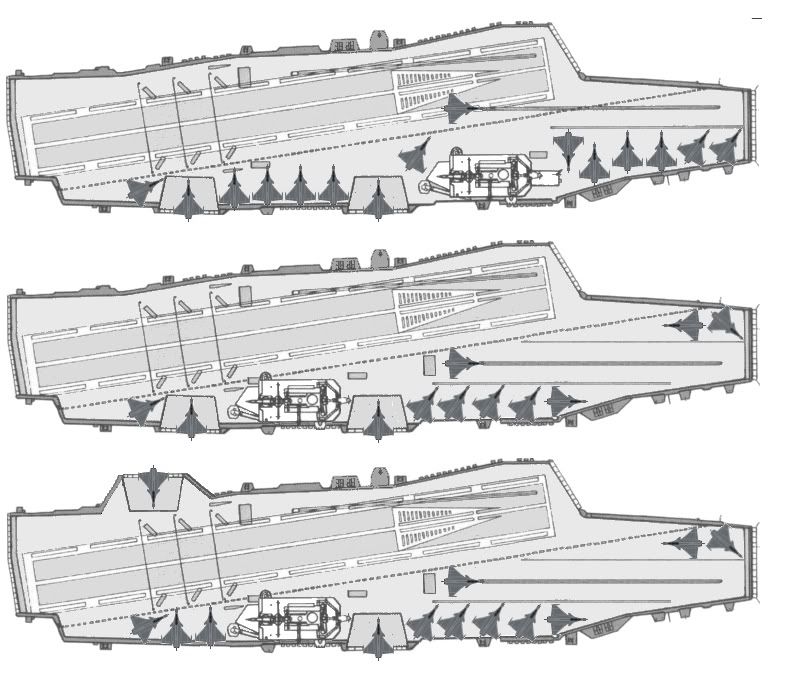
By: - 17th December 2008 at 04:36 Permalink - Edited 1st January 1970 at 01:00
You're right about the weighing parking space vs flow.
@ Option 1: As said, no simultaneous take-off/recovery. A slow-flow layout, it takes a lot of time to clear the landing area. Grave problems for sequential recovery of more than just one flight. The worst option of all.
@ Option 2: Better, since at least the bow cat is de-conflicted. But lifts are clustered around the island, which can be a problem in case of battle damage, since there is some likelhood that a missile would hit the island in case. What is good is that you can simply taxi foward in sequential recoveries, still the bow parking space is limited, and you still have to cross the flight deck to reach the larboard cat. This option looks optimised for rapid launch ops.
@ Option 3: Slightly modified below. The idea is to place the lifts on the far ends of the hangar, to use the larboard cat as standard, and maximise the bow parking space, while at the same time leaving enough space for recovered aircraft to turn towards the forward lift - a nose-first position on the forward lift would be optimal (interesting perspective for the pilot - automation is your friend!), making it easier for the ass-first flow below deck, as no 180 degree is needed. The angle of the landing deck could be reduced by a degree of one-point-five. This option depends requires the placement of the forward cat as far forward and to starboard as possible, and the larboard lift as far aft as the hull permits. To launch a flight, one plane would have to taxi to the bow cat.

Posts: 630
By: H_K - 14th December 2008 at 22:46
I'm launching a thread to discuss medium carriers. We tend to focus a lot on individual designs or light STOVL carriers, but there have been quite a few medium carriers post-WWII that are worth comparing. All are pretty sexy designs.
My definition of a medium carrier is one that can operate supersonic conventional jet fighters, with an airwing of 25-50 aircraft (i.e. Colussus & Majestic class don't count). The range of medium carriers goes from HMS Victorious and FS Clemenceau at the small end of the scale to USS Midway and CVF/PA2 at the high end of the scale. Here's a graphical comparison, with some key statistics: